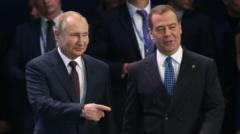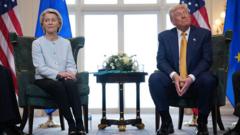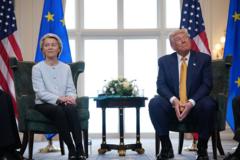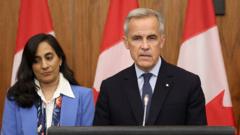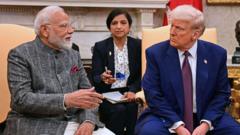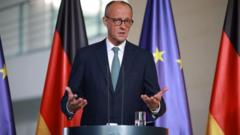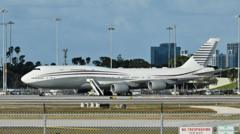With a turbulent trade landscape, both nations navigate a complex relationship as they seek a resolution that benefits both economies.
After a Missed Deadline: What's Next for US-Canada Trade Relations?
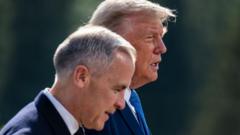
After a Missed Deadline: What's Next for US-Canada Trade Relations?
Following a failed deadline, trade negotiations between the US and Canada face uncertainty amid escalating tariffs.
After the self-imposed deadline for a new trade deal between the US and Canada expired on Friday, questions are emerging about the future of this crucial economic relationship. For six months, the two countries have been engaged in a tariff battle, and despite claims of "intense" negotiations, a satisfactory agreement seems out of reach. Both President Trump and Prime Minister Carney have expressed skepticism about the prospects of a swift resolution, with Trump's comments regarding Canada’s acknowledgment of Palestinian statehood further complicating matters.
The shift from optimism to pessimism contrasts sharply with the sentiments expressed during the G7 meeting in June when both leaders had optimistic hopes of concluding a deal over the summer. The prevailing view now argues that a rushed agreement would be detrimental, as Fen Hampson, a professor at Carleton University, emphasized the importance of quality in any future agreement. Political pressures are mounting, however, as Conservative leader Pierre Poilievre echoed the frustration of Canadians regarding the unmet deadline, urging for a stronger economic strategy from Carney's government.
Currently, a hefty 35% tariff rate looms over Canadian goods, although certain products benefit from exemptions under existing free trade agreements. American tariffs on essential sectors, such as steel and aluminum, are particularly burdensome for Canadian exporters, and the reasoning behind these tariffs has raised questions. While the Trump administration argues that they address issues like drug trafficking, Canada refutes this claim, highlighting that only a fraction of illicit fentanyl in the US comes from its borders.
In response to the aggressive American tariff strategy, Canada has introduced C$60 billion in counter tariffs on various American products, standing as one of the few nations along with China to retaliate against US trade policies. Business leaders are increasingly calling for stability after a period marked by uncertainty and fluctuating trade policies. Catherine Fortin-Lefaivre from the Canadian Chamber of Commerce pointed out that while businesses crave certainty, they are cautious about accepting a subpar deal.
Despite the grim tariff landscape, some experts believe Canada is faring better than it seems. While the perceived tariff rates are high, much of the trade remains tariff-free due to existing agreements like the Canada–United States–Mexico Agreement (CUSMA), allowing nearly 90% of Canadian exports to be traded devoid of additional costs if proper procedures are followed. This provision gives Canada a competitive edge over other nations facing higher tariff rates.
The political implications of ongoing negotiations are not lost on observers. Canadians increasingly view Carney favorably, recognizing the need for measures that are beneficial not only economically but politically. Trump's goal of fostering domestic manufacturing through tariffs and exerting pressure on allies regarding military spending adds another layer of complexity to the discussions.
In recent weeks, Canada has ramped up defense spending, improved border security, and addressed American concerns, indicating their willingness to adapt to US demands. As negotiators continue talks in Washington, both parties acknowledge the necessity for an agreement while simultaneously preparing for the possibility of longer-term changes.
As Canada reassesses its trading relationships, the nation's readiness to diversify trade beyond US reliance is becoming more apparent. With looming challenges regarding CUSMA and the desire to strengthen domestic trading capabilities, it is evident that both nations will need to navigate these turbulent waters carefully. The evolving dynamics of US-Canadian trade highlight the need for strategic decisions as both prepare for ongoing negotiations in this intertwined economic partnership.
The shift from optimism to pessimism contrasts sharply with the sentiments expressed during the G7 meeting in June when both leaders had optimistic hopes of concluding a deal over the summer. The prevailing view now argues that a rushed agreement would be detrimental, as Fen Hampson, a professor at Carleton University, emphasized the importance of quality in any future agreement. Political pressures are mounting, however, as Conservative leader Pierre Poilievre echoed the frustration of Canadians regarding the unmet deadline, urging for a stronger economic strategy from Carney's government.
Currently, a hefty 35% tariff rate looms over Canadian goods, although certain products benefit from exemptions under existing free trade agreements. American tariffs on essential sectors, such as steel and aluminum, are particularly burdensome for Canadian exporters, and the reasoning behind these tariffs has raised questions. While the Trump administration argues that they address issues like drug trafficking, Canada refutes this claim, highlighting that only a fraction of illicit fentanyl in the US comes from its borders.
In response to the aggressive American tariff strategy, Canada has introduced C$60 billion in counter tariffs on various American products, standing as one of the few nations along with China to retaliate against US trade policies. Business leaders are increasingly calling for stability after a period marked by uncertainty and fluctuating trade policies. Catherine Fortin-Lefaivre from the Canadian Chamber of Commerce pointed out that while businesses crave certainty, they are cautious about accepting a subpar deal.
Despite the grim tariff landscape, some experts believe Canada is faring better than it seems. While the perceived tariff rates are high, much of the trade remains tariff-free due to existing agreements like the Canada–United States–Mexico Agreement (CUSMA), allowing nearly 90% of Canadian exports to be traded devoid of additional costs if proper procedures are followed. This provision gives Canada a competitive edge over other nations facing higher tariff rates.
The political implications of ongoing negotiations are not lost on observers. Canadians increasingly view Carney favorably, recognizing the need for measures that are beneficial not only economically but politically. Trump's goal of fostering domestic manufacturing through tariffs and exerting pressure on allies regarding military spending adds another layer of complexity to the discussions.
In recent weeks, Canada has ramped up defense spending, improved border security, and addressed American concerns, indicating their willingness to adapt to US demands. As negotiators continue talks in Washington, both parties acknowledge the necessity for an agreement while simultaneously preparing for the possibility of longer-term changes.
As Canada reassesses its trading relationships, the nation's readiness to diversify trade beyond US reliance is becoming more apparent. With looming challenges regarding CUSMA and the desire to strengthen domestic trading capabilities, it is evident that both nations will need to navigate these turbulent waters carefully. The evolving dynamics of US-Canadian trade highlight the need for strategic decisions as both prepare for ongoing negotiations in this intertwined economic partnership.


